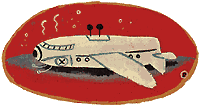
Image: Gary Baseman
Airplane travel takes its toll on even the hardiest of us. It’s not uncommon to experience a stuffy nose, a headache, or a dry throat as we wing across the friendly skies. But what if those minor discomforts turn into something that feels like the flu or a sinus infection when you get home? You’d probably assume you contracted a nasty virus from the passenger who sat next to you. If the plane you were on was treated with a pesticide before you boarded, however, what you might believe is “just a bug” actually may be something more ominous.
Several major U.S. airlines, including American, Continental, Delta, TWA, and US Airways, confirm that they use pesticides “regularly” or “occasionally,” but would not disclose what types they use. At least one airline, Northwest, confirms that it sprays residual—or long-lasting—pesticides on its domestic fleet while the planes are in the hangar.
No federal agency requires pesticide use on planes. So why do airlines spray? “We spray because there is a possibility that insects and rodents can get on board,” says Doug Killian, Northwest’s communications director. “It’s for the safety of our passengers.”
But several pilots and flight attendants, insisting on anonymity, say that airlines spray their planes more for public relations reasons—to prevent travelers from seeing insects or mice—than for health reasons.
According to some scientists, this practice, known as “disinsection,” endangers the health of both passengers and flight staff. In recent years, research by the National Research Council, the National Institute of Environmental Health Sciences, and other groups has linked many ingredients in common pesticides to a variety of ailments, including respiratory problems, skin reactions, nervous system damage, endocrine disorders, increased sensitivity to other chemicals, and cancer.
The Northwest Coalition for Alternatives to Pesticide, an environmental group based in Eugene, Ore., points out that pesticides, while dangerous on land, cause even greater harm when used on planes, because up to 50 percent of the air inside the cabins is recycled. “Pesticides break down slowly in the enclosed, poorly ventilated aircraft,” says NCAP spokeswoman Becky Riley. “Passengers are sealed in a chamber that has been gassed, and sit there for hours.”
Although some airlines, including Continental, claim the pesticides they use are approved by the Environmental Protection Agency, the EPA has only a nominal role in monitoring these products. And despite the overwhelming amount of data on the dangers of pesticides, no federal agency oversees the disinsection of planes.
Saga Multi-Purpose Residual Spray, a pesticide used by Northwest (one of the few airlines to respond in detail to queries), is not even registered for that purpose with the EPA.
According to Joseph Conti, the spokesman for Saga’s manufacturer, AgrEvo (a Montvale, N.J., division of the German chemical giant Hoechst and Schering), Saga is “no longer approved for use on airplanes.” Conti explains that “the EPA [which claims it re-registers chemicals every few years] all of a sudden was requiring a great deal of studies to be done. It was cost-prohibitive.” So, he says, the company removed the claim that Saga was suitable for airline use from the product label.
The EPA relies on the chemical manufacturers themselves to conduct studies demonstrating that the pesticides are “appropriate” for airplane use—a claim the chemical companies can then place on their labels.
 Northwest’s Killian says the Federal Aviation Administration is aware of the company’s use of pesticides, and monitors it. But Don Zochert, public affairs officer at the FAA’s Great Lakes regional office in Des Plaines, Ill., says: “The application of these chemicals is outside of the FAA’s regulatory area of responsibility. We have no role in approving the use of the chemical, nor do we have a role in monitoring or tracking its use.”
Northwest’s Killian says the Federal Aviation Administration is aware of the company’s use of pesticides, and monitors it. But Don Zochert, public affairs officer at the FAA’s Great Lakes regional office in Des Plaines, Ill., says: “The application of these chemicals is outside of the FAA’s regulatory area of responsibility. We have no role in approving the use of the chemical, nor do we have a role in monitoring or tracking its use.”
The Department of Transportation, the other federal agency with regulatory jurisdiction over plane travel, has acted before on the issue of airline pesticide use after a 1994 Condé Nast Traveler article reported that passengers on international flights were being sprayed with dangerous aerosol pesticides, as required by some foreign countries. Prompted by consumer complaints, the DOT wrote letters to each of the countries that required spraying, asking them to disclose which pesticides they use. As a result, the number of countries that still require spraying of pesticides while passengers are on board has dropped from 25 to four—Grenada, Kiribati, Madagascar, and Trinidad and Tobago. (At least six countries—Australia, Barbados, Fiji, Jamaica, New Zealand, and Panama—have switched to using residual pesticides.)
But the DOT has taken no such steps for domestic flights. Bill Mosley, public affairs specialist at the DOT, says: “We know of no particular reason why they would spray. We do not require spraying, but there is no prohibition against carriers doing it if they wish.”
Exposing travelers on domestic flights to dangerous chemicals is not new. From 1944 until the late 1970s, airlines sprayed DDT on their planes, sometimes even while passengers were on board. And from 1986 to 1996, Northwest Airlines used Bolt, a pesticide that contains chlorpyrifos, a potential nervous system poison. In 1994, the Journal of Pesticide Reform reported that chlorpyrifos may cause symptoms ranging from nausea to convulsions, and may also produce birth defects and other genetic damage in humans.
Mosley says the DOT is campaigning to stop the practice of spraying while passengers are on board, but says that “spraying while no one is on board doesn’t raise the same concerns.”
Many scientists disagree. For example, Bill Plapp, an insecticide toxicologist formerly with the University of Arizona, says Saga’s active ingredient is tralomethrin, a synthetic pyrethroid that studies show can cause reproductive and other health problems.
“Tralomethrin is the most ‘DDT-like’ of the things we have these days,” he says, citing lowered sperm counts and carcinogenicity as problems associated with the chemical.
“Airlines have no business doing it,” says Plapp. “It’s stupid and if it isn’t illegal, it ought to be. Exposing people to pesticides in case there are insects makes no sense. People should have the right to transportation without being subject to a health hazard.”
“This practice is insanity,” agrees Dr. Jack Thrasher, an immunotoxicologist in Alto, N.M. Tralomethrin contains bromide, a chemical Thrasher says has been shown to cause thyroid disease in animals. He also says other chemicals in tralomethrin can create allergic reactions and exacerbate asthma. “They have no business spraying pesticide. I don’t care if it’s .05 percent,” Thrasher says.
Instead of fleetwide spraying with residual pesticides, there are less dangerous ways to take care of bugs, says Sheila Daar, director of the Bio-Integral Resource Center in Berkeley, Calif., which specializes in nontoxic methods of weed and pest control. Daar says cleaning crews should be taught to monitor each plane using sticky or pheromone traps to determine if there is a problem first.
“Affected planes can be treated in a number of inexpensive ways that don’t involve volatile materials, or [that use] only low-toxic methods such as caulking cracks, traps, boric acid gels, or paste in a bait station at entry points or hiding places,” says Daar. She notes that insects rapidly develop resistance to pesticides.
That is just one reason why many experts point out that pesticide use on planes is not only dangerous, but useless. As far back as 1983, then Assistant Surgeon General Donald Hopkins said that “disinsection of aircraft has never been shown to be highly effective in disease control and prevention.”
University of Minnesota entomologist Dave Noetzel agrees. “If an insect walks through the pesticide,” he says, “[the pesticide] will do the job.” But it’s overkill. “[Spraying pesticides] is a meaningless procedure. I find it difficult to believe it’s done.”
Karin Winegar is a staff reporter for the Minneapolis Star Tribune. She reported on the use of aerosol pesticides on international flights for Condé Nast Traveler in March 1994.












